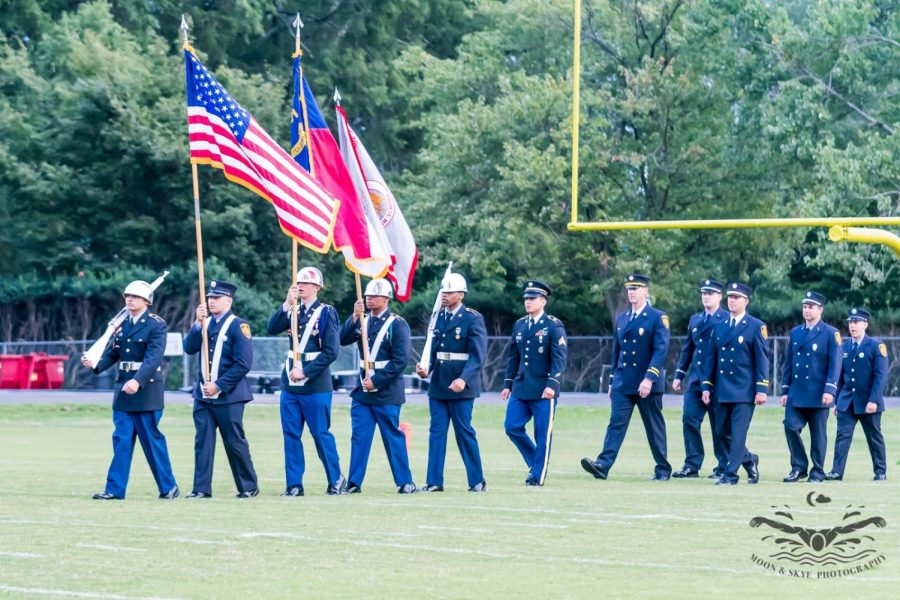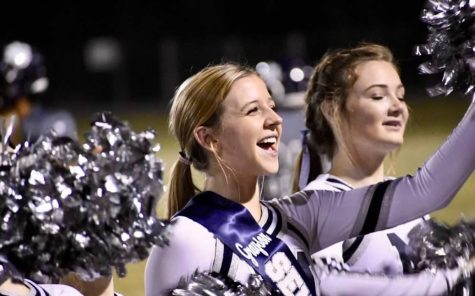A look inside of J.R.O.T.C.
Marching in during the patriotic football game, JROTC’s Color Guard carries the nation’s colors in, joined by Raleigh’s Fire Department. JROTC is a program held at Millbrook that includes students who want to work on their leadership, excellence, and discipline.
December 18, 2019
JROTC is the Junior Reserve Officer Training Corps and can be identified as the students who wear uniforms throughout the week, say the “Pledge of Allegiance” over the intercom, and march with the flag at sports games. However, JROTC is much more than this. This program has been stereotyped as a recruiting program for the military, or for students who need discipline, but that is far from the truth. JROTC is for students who want structure, who want to mature, and who want to overall be better citizens.
Every day of the week, the program is doing something different. On Mondays, they have Drill and Ceremony. D&C is where they break into groups and work on their sharp movements while marching. These groups are called platoons. Each platoon has 12 members with a platoon sergeant, or leader, in charge. Within these groups, in addition to marching and working on movements, the students continue to work on order. On Tuesdays and Thursdays, they are in a regular classroom setting. From there, the program is split into 2 groups: the LET 1s and the LET 2s, 3s, and 4s. LET stands for Leadership Education Training, and the number is based off how many years you have been in the program. For example, LET 1s, or first-year JROTC students, will be in their own separate classroom to learn the basics of the program. The other students are in another classroom, working on perfecting their skills and taking them to a higher level. Here they learn about public speaking, leadership, and growing confidence. On Wednesdays, the students are required to wear their ASUs, or Army Service Uniforms, and from there they get inspected. For girls, their hair needs to be in a slick-back bun, and their hair cannot touch the collar on their uniform. For boys, their hair cannot touch their ears or neck nor exceed 3 inches in bulk, and their sideburns can not go past the middle of their ear. Finally, Fridays are saved for Physical Training. In PT, they wear a uniform, and spend the day doing different types of physical activity. This includes days focused on muscle, endurance, and cardio.
Outside of school, JROTC participates in many activities as a program. Each Company participates in a Service Learning Project. This can be anything to make the school or community better. They also compete in competitions against other high schools on the Raider, Drill, and Exhibition teams. The Raider team can be described as the “jocks” of the program. They compete by completing obstacle courses, and on October 17, they placed very high at Knightdale High School. The Drill team can be seen marching after school, and this team takes it seriously. They focus on their movements and being tight, and they compete to win awards. The Exhibition team competes by spinning rifles and can be described as a discipline step team.
JROTC puts people in positions in which they need to take control and display confidence. In addition to the classroom aspect, JROTC is a family. Cadet Command Sergeant Major Gibson said that “freshman and sophomore year I avoided talking to people, and JROTC has allowed me to do so many things that I couldn’t have done without it. No matter what, you have a family.” JROTC has allowed many people to step outside their comfort zones and introduced them to something that they have grown to love. The impact of the JROTC community on those involved is fully represented in their mission statement, which is “to motivate young people to be better citizens.”












